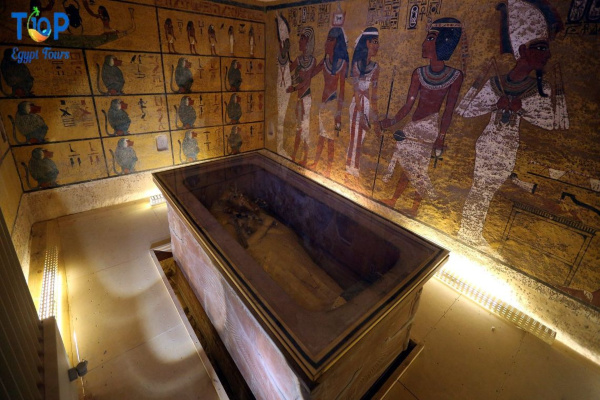Secrets of Tutankhamun’s Tomb, Nestled along the fertile banks of the Nile River lies the captivating city of Luxor, a place steeped in the mystique of ancient Egyptian history. As part of the cluster page dedicated to “Egyptian Ancient Thebes: Luxor and Karnak Temples,” we delve into the heart of the Valley of the Kings to unravel the enigmatic secrets hidden within the burial chamber of one of Egypt’s most iconic pharaohs – Tutankhamun.
The Discovery Of Secrets of Tutankhamun’s Tomb:
The year was 1922 when British archaeologist Howard Carter unearthed the entrance to Tutankhamun’s tomb in the Valley of the Kings. The discovery marked a turning point in the world of archaeology, as the untouched burial chamber revealed an unparalleled trove of artifacts, providing a rare glimpse into the life and afterlife of the young pharaoh.
Buried with flowers
When Tutankhamun’s tomb was opened in 1922, he was wearing a collar made of flowers, and it was in good condition because it was tight inside the coffin. Funeral rose bouquets were also found in other mummies, pointing out that this is the only royal burial, where they were found. All flowers are exactly as they were left by ancient Egyptian mourners.
The Golden Death Mask Of King Tut:
Tutankhamun’s tomb, often referred to as the “Boy King’s” resting place, was a treasure trove of exquisite artifacts. Among the most stunning finds was the golden death mask that adorned the mummy of the pharaoh. Crafted with meticulous detail, the mask is a symbol of the opulence and artistic brilliance of ancient Egyptian civilization.
King Tut was sitting inside four gilded funerary coffins, and he was wearing a golden death mask on his face. The mask, which weighs ten kilograms, depicts the king as a god carrying a staff and a flail. It was polished from gold, lapis lazuli, and precious stones in an amazing way in terms of the precision of the design and its splendor, so much so that one might think that whoever By refining it in this way, he used modern machines, not the hands of the Egyptians three thousand years ago or more.
The Curse of the Pharaoh:
The unearthing of Tutankhamun’s tomb also brought forth tales of the infamous “Curse of the Pharaoh.” A superstition that claimed those who disturbed the resting place of the ancient ruler would face misfortune and death. While scientific minds dismiss such notions, the legend adds an air of mystery to the already captivating narrative of Tutankhamun’s tomb.
Unraveling the Mysteries:
As the layers of history are peeled away, archaeologists continue to unravel the mysteries surrounding Tutankhamun’s life and death. The intricately decorated walls of his tomb depict scenes from the afterlife, offering insights into the religious beliefs and rituals of ancient Egyptians. Each artifact, from the elaborate chariots to the meticulously crafted jewelry, tells a story of a bygone era.
The Eternal Legacy Of King Tutankhamun:
Tutankhamun may have ascended to the throne at a tender age, but his legacy endures through the artifacts discovered in his tomb. The treasures not only showcase the artistic prowess of the time but also shed light on the political and cultural landscape of ancient Egypt during the 18th dynasty.
As you explore the wonders of Egyptian Ancient Thebes, Luxor, and Karnak Temples, don’t miss the opportunity to stand in awe before the secrets unveiled in Tutankhamun’s tomb. The Boy King’s burial chamber remains a testament to the enduring allure of ancient Egypt, inviting visitors to step back in time and witness the splendor of a civilization that continues to captivate the world.



Comment (0)